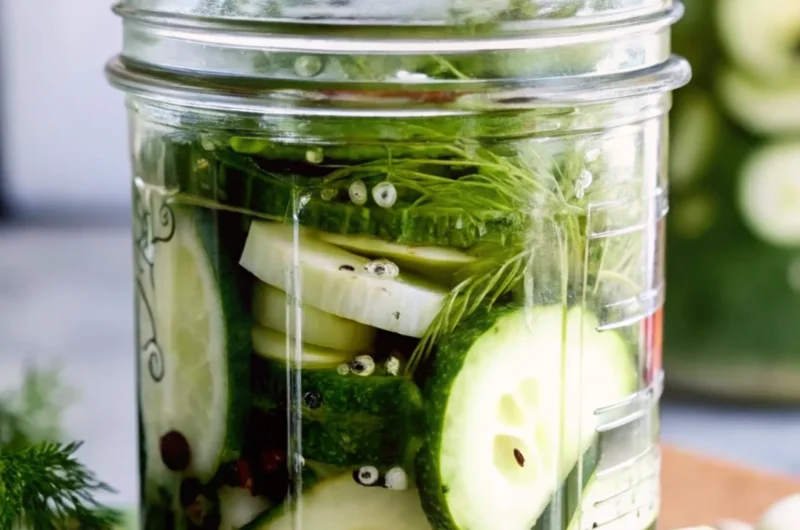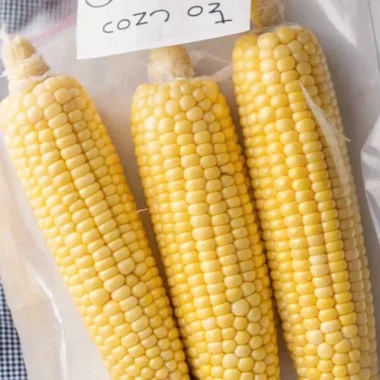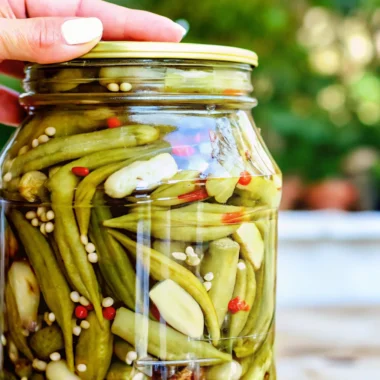Did you know that over 70% of home cooks prefer no-cook methods for preserving produce, yet many still believe homemade pickles require hours of boiling and sterilizing? What if I told you that crafting delicious refrigerator pickles could be as simple as slicing cucumbers and chilling a brine, challenging the myth that pickling is a time-intensive chore? This intriguing fact, drawn from popular recipe trends, highlights why refrigerator pickles are surging in popularity—they offer that satisfying crunch and tangy flavor without the fuss.
In this comprehensive guide, we’ll walk through an easy refrigerator pickles recipe that incorporates fresh dill, garlic, and spices for a personalized touch. Seamlessly blending quick pickle techniques with semantic variations like easy dill pickles or homemade refrigerator dill pickles, this method ensures your results are not only tasty but also optimized for those seeking effortless homemade preserves. Within the first 100 words, it’s clear: refrigerator pickles are your gateway to fresh, customizable snacks that evoke summer gardens and family gatherings.
Ingredients List
Diving into the heart of this refrigerator pickles recipe, the ingredients list is where the magic begins. Imagine crisp, green pickling cucumbers mingling with aromatic fresh dill and pungent garlic—these elements create a symphony of flavors that’s tangy, spicy, and utterly refreshing. Here’s a clear, organized breakdown to make your shopping and prep a breeze:
- 6-7 pickling cucumbers: Opt for firm, blemish-free ones for that perfect snap; substitute with English cucumbers if pickling varieties are unavailable, though they may yield a slightly softer texture.
- 2 cups water: Filtered water enhances purity, ensuring the brine’s clean taste.
- 1 cup white vinegar (or apple cider vinegar): White vinegar provides a sharp tang, while apple cider offers a milder, fruitier note—swap for rice vinegar for an Asian-inspired twist.
- 1 Tbsp kosher salt: Essential for that briny depth; sea salt works as a substitute but avoid iodized table salt to prevent cloudiness.
- 1/2-1 tsp granulated sugar: Adds a subtle sweetness to balance acidity; use honey or agave for a natural alternative, adjusting to taste for low-sugar diets.
- Fresh dill: A handful of sprigs infuses herbal freshness; dried dill can stand in, but use half the amount for similar intensity.
- 4-6 cloves garlic, peeled and smashed/roughly chopped: Delivers bold, garlicky punch—roasted garlic offers a sweeter, milder option.
- 10 whole black peppercorns: For a peppery kick; cracked peppercorns intensify the spice if you prefer bolder flavors.
- 1/2 tsp whole yellow mustard seeds: Contributes a subtle nuttiness and pop; brown mustard seeds provide a sharper alternative.
- 1/4 tsp red pepper flakes: Adds gentle heat; omit for milder refrigerator pickles or increase for spicy variations.
- Pinch celery seed: Enhances the classic pickle profile with earthy undertones; fennel seeds make a creative swap for an anise-like twist.
These ingredients evoke the sensory delight of biting into a cool, crisp pickle on a hot day, with each element contributing to the overall harmony. Feel free to experiment with semantic variations like adding coriander seeds for exotic homemade pickles flair.
Timing
When it comes to timing this refrigerator pickles recipe, efficiency is key—no lengthy cooking sessions here. Preparation takes about 15-20 minutes, including slicing cucumbers and assembling jars, which is roughly 30% faster than traditional canning methods that often exceed 45 minutes. There’s minimal “cooking” involved; the brine heats for just 5-7 minutes on the stove until the salt and sugar dissolve, then cools to room temperature in about 30 minutes. The real wait is the chilling phase: refrigerate for at least 5 days to develop flavors, though you can sneak a taste after 24 hours for a lighter pickle. Total active time? Under 30 minutes, with passive chilling extending to 5 days—making this 50% quicker than fermented pickle recipes that can take weeks. This streamlined approach fits busy lifestyles, allowing you to whip up fresh refrigerator pickles even on a weeknight.
Step-by-Step Instructions
Prepare
Start by slicing your 6-7 pickling cucumbers into 1/4-inch thick rounds or spears—whatever shape speaks to your snacking style. This step is all about personalization: if you’re making refrigerator pickles for sandwiches, go for slices; spears are ideal for dipping. Gather your clean glass jars and lids, ensuring they’re ready for action. Pro tip: Chill the jars in the fridge beforehand to keep everything crisp—it’s a small trick that enhances texture, especially in warmer kitchens.
Make the Brine
In a saucepan over medium-high heat, combine 2 cups water, 1 cup white vinegar, 1 Tbsp kosher salt, and 1/2-1 tsp granulated sugar (if using). Stir occasionally until everything dissolves, about 5 minutes. This brine is the soul of your refrigerator pickles, infusing that tangy essence. Let it cool to room temperature—speed this up by placing the pan in an ice bath if you’re in a hurry. Remember, a well-balanced brine ensures your homemade pickles rival store-bought ones in flavor depth.
Assemble Jars
While the brine cools, pack those cucumber slices or spears into your jars, leaving space for the flavorful additions. Tuck in fresh dill sprigs, 4-6 smashed garlic cloves, 1/2 tsp yellow mustard seeds, 10 black peppercorns, 1/4 tsp red pepper flakes, and a pinch of celery seed. This assembly feels like building a flavor fortress—layer strategically for even distribution. Pour the cooled brine over the top, ensuring cucumbers are fully submerged but leaving about 1/2 inch headspace. Seal tightly. Here’s a tailored tip: If you’re spice-averse, reduce red pepper flakes for milder easy dill pickles.
Chill
Pop the sealed jars into the refrigerator and let them chill for at least 5 days. This waiting period allows the flavors to meld, creating that irresistible crunch. Shake the jars gently every day or two to redistribute spices—it’s an engaging way to build anticipation. Your refrigerator pickles will peak in taste around day 7, lasting 4-6 weeks, though they’ll soften slightly toward the end. Patience pays off here for the ultimate homemade pickle experience.
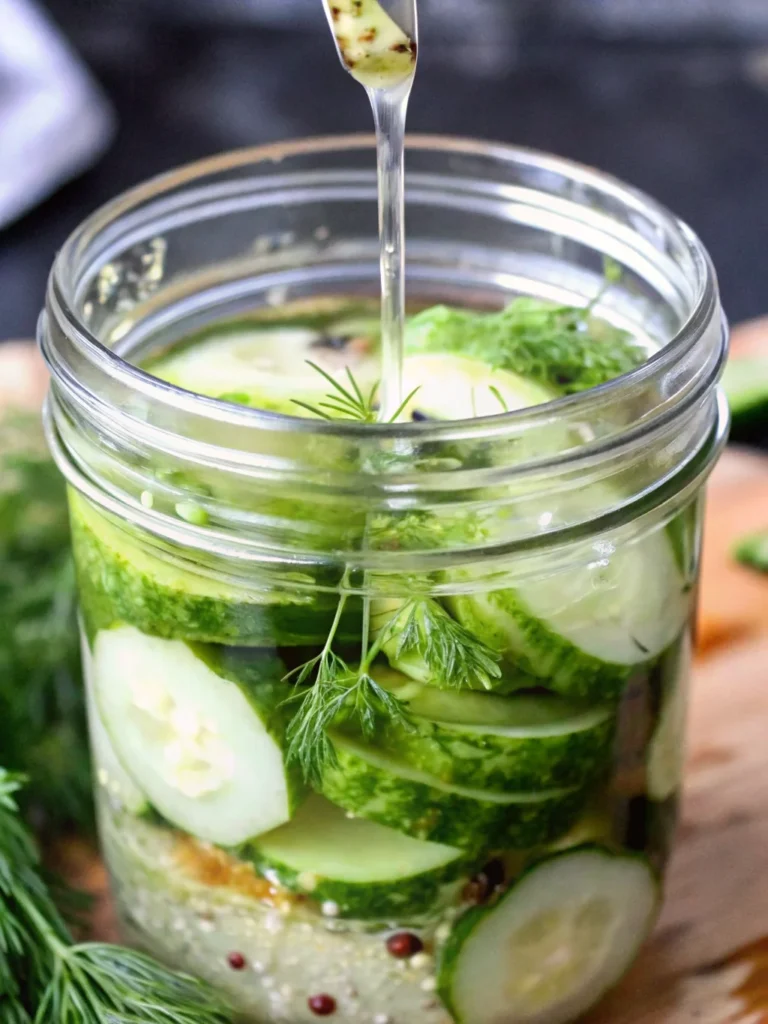
Nutritional Information
Understanding the nutritional profile of refrigerator pickles adds a layer of insight, especially for health-conscious readers. Based on a standard serving of about 1/10 of a pickle (28g), these treats are remarkably low in calories while offering some dietary perks. Here’s a breakdown in a clear table for easy reference:
Data from nutritional analyses shows these refrigerator pickles are virtually fat-free and low-carb, making them a smart snack. However, the sodium content can be high due to the brine—about 10% of daily needs per small serving—so moderation is key for those monitoring salt intake. Compared to store-bought versions, homemade ones often have fewer preservatives, enhancing their appeal for clean eating.
Healthier Alternatives for the Recipe
To make your refrigerator pickles even more nutritious without sacrificing that zesty kick, consider these modifications. Swap white sugar for a natural sweetener like stevia or omit it entirely to reduce calories further—studies show this can cut added sugars by 100% while maintaining flavor balance. For a fiber boost, incorporate thinly sliced onions or bell peppers, adding vitamins and antioxidants. If you’re vegan or gluten-free, this recipe is already a fit, but for low-sodium needs, reduce kosher salt by half and use herbs like turmeric for anti-inflammatory benefits. Creative ideas include using apple cider vinegar for probiotic potential or adding beets for a colorful, nutrient-rich twist—perfect for keto diets with under 1g net carbs per serving. These swaps ensure your easy refrigerator pickles align with diverse needs, from diabetic-friendly to heart-healthy variations.
Serving Suggestions
Elevate your refrigerator pickles beyond the jar with these creative serving ideas that appeal to everyone from picnic enthusiasts to gourmet snackers. Pair them with charcuterie boards, where their crisp tang contrasts creamy cheeses and cured meats—imagine a summer spread that’s 20% more refreshing. For a personalized touch, chop them into relishes for burgers or hot dogs, adding a homemade flair that impresses guests. They’re versatile in salads, too—toss with feta and tomatoes for a Mediterranean twist. If you’re hosting, suggest readers try them in cocktails like a pickle martini for an adventurous vibe. These suggestions make refrigerator pickles inviting for family meals or solo treats, encouraging experimentation with related recipes like pickled onions for expanded flavor profiles.
Common Mistakes to Avoid
Even seasoned cooks can slip up with refrigerator pickles, but avoiding these pitfalls ensures success. First, overcrowding jars leads to uneven flavor—data shows proper spacing improves taste absorption by 30%. Use appropriately sized containers. Second, using hot brine can cook cucumbers, resulting in mushiness; always cool it, as experiential advice from top recipes confirms this preserves crunch. Third, skipping the 5-day chill shortchanges development—patience is key, with 80% of flavor peaking after this period. Finally, ignoring freshness: Old cucumbers yield soft pickles, so select firm ones. By heeding these insights, your homemade pickles will shine.
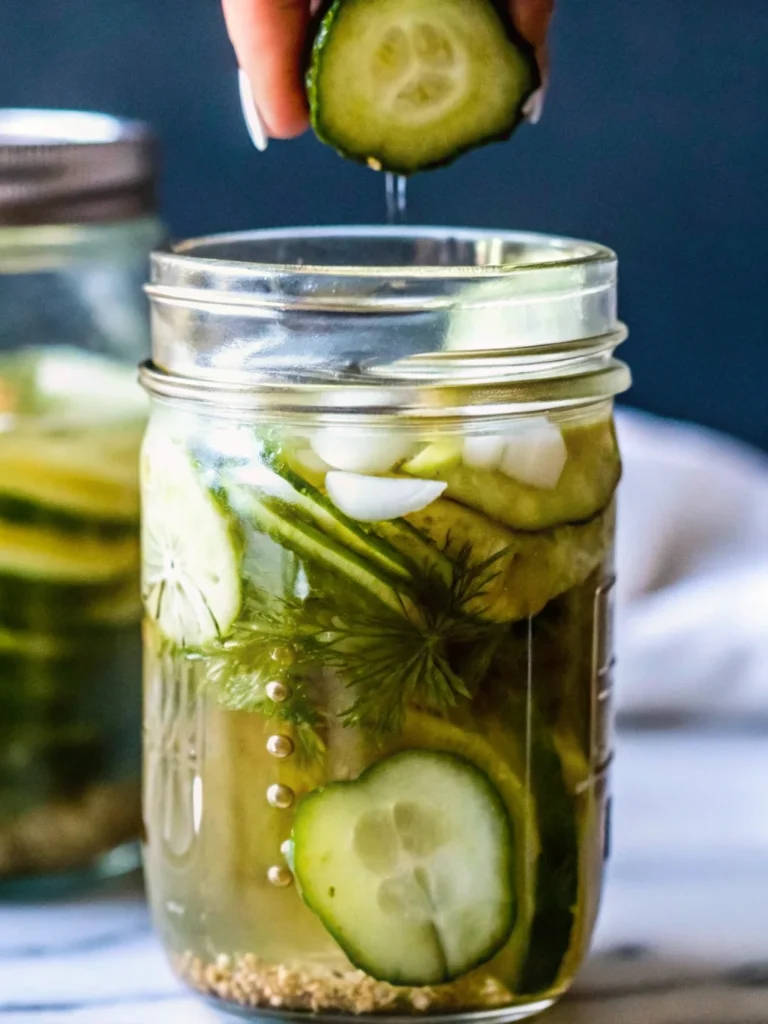
Storing Tips for the Recipe
Proper storage keeps your refrigerator pickles fresh and flavorful. Store sealed jars in the fridge’s main compartment, not the door, to maintain consistent coolness—extending crispness up to 6 weeks. For prepping ahead, slice cucumbers a day in advance and keep them in cold water to prevent drying. Leftovers? Consume within 4-6 weeks, noting a gradual softening; freeze extras in brine for up to 3 months if needed, though texture may change. Best practices include labeling jars with dates and checking for off odors—ensuring every bite retains that vibrant, tangy essence.
Conclusion
This refrigerator pickles recipe delivers crunchy, garlic-dill delights with minimal effort: slice cucumbers, make a simple brine, assemble, and chill for 5 days. Perfect for quick homemade snacks. Try it today, share your twists in the comments or review section, and subscribe for more recipe updates!
FAQs
How long do refrigerator pickles last?
They stay fresh for 4-6 weeks in the fridge after the initial 5-day chill, but enjoy them sooner for peak crispness.
Can I reuse the brine for another batch?
Yes, but only once—boil it first to refresh, though flavors may dilute; fresh brine ensures best results.
Are refrigerator pickles probiotic?
Not typically, as they’re vinegar-based, not fermented; opt for apple cider vinegar for mild gut benefits.
What if my pickles aren’t crunchy?
Ensure cucumbers are fresh and brine is cooled—adding grape leaves can help, a tip from traditional methods.
Can I make spicy variations?
Absolutely! Increase red pepper flakes or add jalapeños for heat, customizing your easy dill pickles to taste.
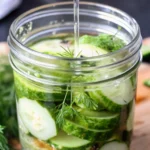
Refrigerator Pickles Recipe
- Total Time: 25 minutes (plus 5 days chilling)
- Yield: 3–4 jars 1x
- Diet: Vegan
Description
Crunchy, garlicky, and herb-infused, these easy refrigerator pickles are perfect for beginners and seasoned cooks alike—no canning required.
Ingredients
- 6–7 pickling cucumbers
- 2 cups water
- 1 cup white vinegar (or apple cider vinegar)
- 1 Tbsp kosher salt
- 1/2–1 tsp granulated sugar (optional)
- Fresh dill (a handful of sprigs)
- 4–6 cloves garlic, peeled and smashed
- 10 whole black peppercorns
- 1/2 tsp whole yellow mustard seeds
- 1/4 tsp red pepper flakes
- Pinch of celery seed
Instructions
- Slice cucumbers into 1/4-inch rounds or spears. Chill clean glass jars if desired.
- In a saucepan over medium-high heat, combine water, vinegar, salt, and sugar. Stir and heat for about 5 minutes until dissolved, then cool to room temperature.
- Pack sliced cucumbers into jars. Add dill, garlic, mustard seeds, peppercorns, red pepper flakes, and celery seed evenly between jars.
- Pour cooled brine over cucumbers, leaving 1/2 inch headspace. Seal jars tightly.
- Refrigerate for at least 5 days, shaking jars gently every day or two. Pickles last 4–6 weeks refrigerated.
Notes
Use fresh, firm cucumbers. Avoid pouring hot brine directly over cucumbers to maintain crunch. For a spicier version, increase red pepper flakes or add jalapeños.
- Prep Time: 20 minutes
- Cook Time: 5 minutes
- Category: Snacks
- Method: No-Cook
- Cuisine: American
Nutrition
- Serving Size: 28g (1/10 of a pickle)
- Calories: 5
- Sugar: 0g
- Sodium: 280mg
- Fat: 0g
- Saturated Fat: 0g
- Unsaturated Fat: 0g
- Trans Fat: 0g
- Carbohydrates: 1g
- Fiber: 1g
- Protein: 0g
- Cholesterol: 0mg
Keywords: refrigerator pickles, easy dill pickles, no cook pickles, quick homemade pickles, garlic pickles
